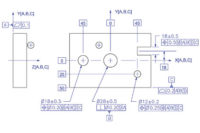In mass-production industries, it has been realized that Product Design (PD) departments and Manufacturing Engineering (ME) departments under the same organization show quite different interests in the same product line. PD cares more about product performance. However the profound knowledge on the relationship between product tolerances and product performance gradually gets lost through generations and evolvement of product development. As a result, PD tends to put on the same or similar critical tolerances as new products continue to be developed, which in some cases should be tightened for required performance or can be relaxed for lower manufacturing cost.
Whereas ME is more interested in throughput that meets the specs. However, specs tend to be interpreted in a traditional and easy way that ME feels more comfortable with unless instructed differently by the PD and quality departments. This leads to some quality chasms that can cause unnecessary downstream operations and possible expensive quality problems. The emergence of micron-accurate optical inspection technologies to enable total surface visualization on critical mating surfaces provides an unbiased link across different departments within the organization and between manufacturers and suppliers to prevent quality issues from passing through the product life cycle.
Flatness, by GD&T definition1 and ISO2 standards, is the distance between two parallel planes to enclose all produced features. Here, “all” produced materials on the specified surface must be counted for flatness by definition because “all” produced materials contribute to the functionality by design, which is assumed reasonable. Same applies to other surface GD&T specs, such as profile, parallelism, waviness, etc. However, when it comes to merging theory with reality, due to the demand for productivity and a limitation of metrology technologies available at the time, traditionally, these surface specs are inspected at very limited surface sampling rate. Over time, this practice has been widely accepted by the industry as a standard, and eventually becomes a mentality.
The recently emerged tunable laser holographic interferometry technology3, originated from Ann Arbor, Michigan, provides a unique capability of micron-accurate total surface visualization on precision machined prismatic surfaces in minutes. Compared to other traditional interferometry technologies, which use a single wavelength that limits their height measurement range no more than half of wavelength, it utilizes a tunable laser to achieve up to 24mm height measurement range in micron-level accuracy across a 150mm x 150mm (or 280mm x 280mm) field of view in one data capturing cycle. Its recent development on lateral multi-view stitching? for parts larger than the field of view and multi-surface relationship by utilizing artifacts to extend its measurement range from only one side of the part to multiple sides significantly enhances its practical use by industry.
Figure 1 shows a comparison between (a) traditional measurement technology (coordinate measurement machine - a common practice by the industry today), and (b) tunable laser holographic interferometry technology on the same automotive engine head deck face. By design, engine heads and engine blocks are assembled together on the deck face to build an enclosed combustion chamber for each cylinder. Flatness at global and local scale, and micro surface texture such as waviness on entire deck face, are critical to an engine’s sealing performance. However, traditional measurement only provides about 15,000 points for more than nine minutes to cover about 1% of the entire deck face. In comparison, a 99% surface coverage with over 2,400,000 points can be provided by new technology in less than four minutes. This does not only provide the capability for industry to measure to specs,but also enables total surface visualization for any possible quality negligence by traditional inspection technologies.
Figure 2 shows the tunable laser holographic interferometry measurement of multiple surfaces (cam rail, cam cap joint, bolt hole tops, spark plug tops, and a few others), all on the top side of the engine head with respect to the deck face as the datum. This measurement is acquired by using external references to build up a relationship between opposite sides of the part. The color variation on each surface indicates deviation from its respective nominal profile, with respect to the datum of deck face. This again provides industry the capability to measure to specson critical multiple surface relationship.
In conclusion, the GD&T surface specs such as flatness, parallelism, and profile are on the entirefunctional surface by definition but traditional practice in industry has been developed into discrete low surface sampling due to the limitation of the inspection technologies available at the time. The emergence of new optical precision inspection technologies provides industry the capability to measure to specswith total surface visualization information that helps prevent expensive quality problems.
References
[1]. James D Meadows, Geometric Dimensioning and Tolerancing, 1995
[2]. ISO 1101:2004
[2]. Carl Alexoff, Multi-Wavelength Digital Holographic Metrology, Proc. SPIE 6311, Optical Information Systems IV, 63111D, August 30, 2006
[3]. Zhenhua Huang, Albert Shi, and Jun Ni, Laser Interferometry Hologram Registration for Three-Dimensional Precision Measurements, Journal of Manufacturing Science and Engineering, Vol. 128, 2006




